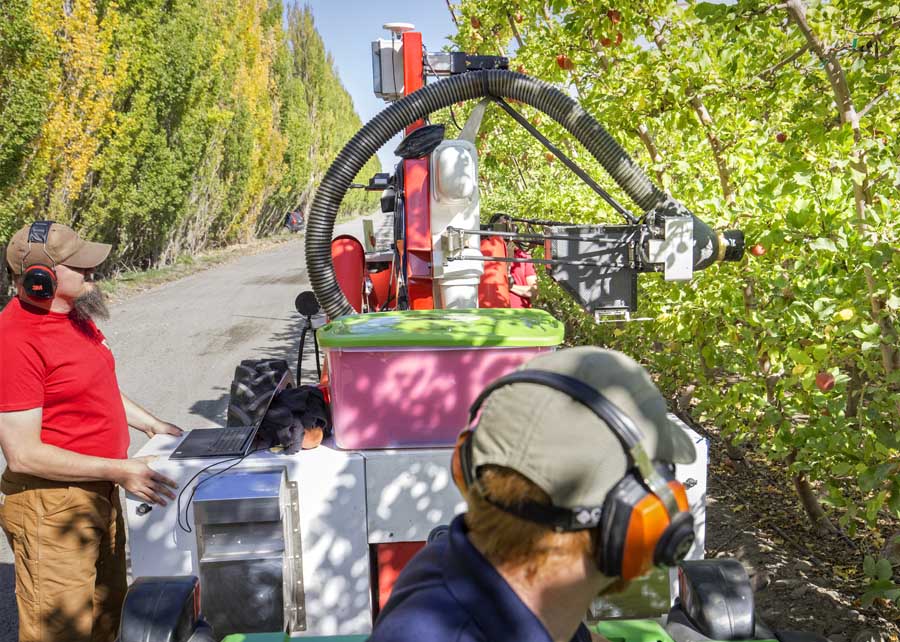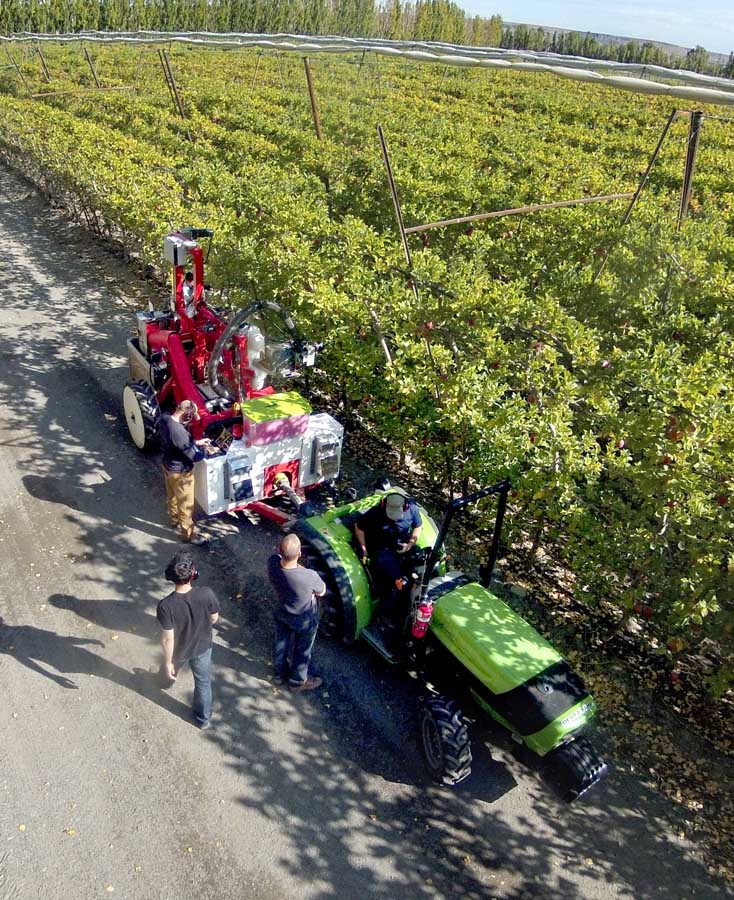It’s no secret that hired labor is the most significant variable cost in apple production, representing as much as half a grower’s total production costs, and many labor-intensive tasks are time sensitive.
None more so than harvest. Decades ago, as Washington growers faced a shortage of workers, the industry identified harvest automation — development of a machine that could pick the fruit as quickly as people could without damaging trees or bruising fruit — as a research focus.
Yet today, even though some growers have deployed modern mechanical platforms to speed workers and reduce the risk of falls from ladders, thousands of people are still needed to manually pluck apples from trees each season.
So, when might automation of apple harvest become a reality? Perhaps sooner than you think.
A vacuum harvester under development by Abundant Robotics of Menlo Park, California, has the apple industry closer than it’s ever been to fully automating harvest — a potential game changer for growers and the industry at large.

Operators of an Abundant Robotics automated vacuum harvester monitor the test vehicle working a Fuji apple block during the 2016 Washington apple harvest. (TJ Mullinax/Good Fruit Grower)
Abundant CEO Dan Steere is careful about making any pronouncements that could sound like promises to the industry.
Though the company is moving into a commercialization phase with its technology, it still has work ahead to perfect the machine. But the goal is to have the first such harvester working commercially in orchards in 2018.
A long process
Evolving technologies have been gradually changing the way the apple industry does business for years.
Advancements in optical scanning and robotic systems are elevating packing houses to new levels of efficiency and production. In the orchard, growers are employing temperature and moisture sensors, GPS technology and aerial imaging to better manage orchards and quickly recognize problems.
Picking fruit is another story. An orchard is not a standardized work environment, and any number of variables, including ground slope, trellis type and angle, pruning style and even weather, complicate mechanization efforts. In addition, the human mind makes hundreds of minor decisions in the orchard each day, something a robotic harvester must be able to do as well.
“We’re asking a lot when it comes to something as complex as an automated harvester,” said Jim McFerson, director of Washington State University’s Tree Fruit Research and Extension Center and former manager of the Washington Tree Fruit Research Commission. “But when you really examine any major technological innovation — I suspect it’s true in areas of agriculture and many other areas — it doesn’t seem to come quickly or smoothly or ever ahead of schedule.”
The Research Commission, which identified an automated harvester as a research focus as early as 1969, has helped to fund several research projects toward that goal over the years, but there have been challenges:
Development of an automated tomato harvester in the 1960s raised concerns about the societal impacts of mechanizing horticulture and displacing thousands of workers. Enthusiasm — and in some cases funding — waned for automation research, creating a gap in graduate students, scientists and engineers to help develop automation technologies for agriculture. “We haven’t really caught up,” McFerson said.
A gulf between research and application creates a high hurdle for anyone looking to bring a product to market.
“It’s so difficult to get through this no-man’s land, and there’s extra effort you have to go through to close this gulf,” said Jim Doornink, a longtime grower in Washington’s Yakima Valley and board member of the Washington Tree Fruit Research Commission.
Often, technologies developed for other industries with greater likelihood for widespread adoption are refined for agriculture, he said, such as the sensor technologies and electronics that were adapted for packing lines.
“Then, somewhere in there you have to convince the vendor, who is oftentimes in opposition to the idea, that there’s a million units that can be sold, enough that they should make the product,” he said.
It’s also taken years for the technology — the cameras, sensors and engineering — to catch up with the idea of an automated apple harvester.
Pursuing the goal

Workers from Abundant Robotics demonstrated their automated vacuum harvester in an apple block in Vantage, Washington, on Sept. 22. (Shannon Dininny/Good Fruit Grower)
Three years ago, a researcher for SRI International, an independent, nonprofit research and development organization with headquarters in California’s Silicon Valley, began a research project to develop a robotic apple harvester.
That researcher, Curt Salisbury, grew up on the edge of southeast Washington’s apple country and saw the potential.
A consultant to SRI’s ventures group, Steere joined the team in spring 2015 and, after about six months together, he and Salisbury spun off a new company with a goal of commercializing the still-under-wraps technology.
They launched Abundant Robotics five months ago with investment capital largely from investors in Silicon Valley.
Steere noted the U.S. tree fruit industry is extremely sophisticated in multiple ways: horticulturally, operationally and in the types of available data that are typical of well-managed orchards.
“The better those management practices are, the better equipped people are to both make decisions about what automation can help with and to implement them,” he said.
Abundant Robotics has worked closely with a cross section of the apple industry, both in the U.S. and abroad, to understand the needs and learn how to best apply the technology to meet multiple demands.
The engineering requires a design that’s reliable, hits a certain cost and performance targets, and that single piece of engineering must integrate and function alongside a lot of other systems.
“We’ve spent a lot of time in the last couple of years just trying to learn about different orchard systems and then trying to understand what systems work best,” Steere said.
In other agricultural systems, if an automated harvester gets to the point where damage to the plant or the produce is minimal, then automation has happened.
“But for all the sectors where the produce can’t withstand that kind of rough treatment, there’s been very little automation,” he said. “There’s this perception that ag is slower to adopt new technologies, but I don’t see that.”
Therein lies another challenge. Abundant Robotics isn’t ready to offer any specific recommendations yet to growers to prepare their orchards for automation, and despite the potential benefits, many people are wary of change.
“If the old system is working reasonably well, the new system that is going to replace it is going to have to work significantly better,” Doornink said. “You don’t change to get the same effect. You will make the incremental change if you can do it faster, better, cheaper.”
Growers may be forced to adapt to the changes around them though, he said. As demographics shift around the world, the labor pool U.S. growers have tapped for the last 50 years is changing. It seems natural to bring in some automation.
“This project is critically timed. I don’t think in the history of tree fruit, I don’t think there’s another time this could have been accomplished,” Doornink said. “Everything is just right — the need is here, computers have developed sufficiently, and the industry is prosperous and can make a change like this.
“It’s a great time for this to happen,” he said. “Now we just have to wait and see.” •
– by Shannon Dininny / photos by TJ Mullinax






Leave A Comment